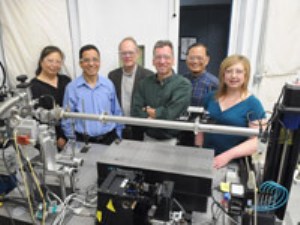A research team from the U.S. Department of Energy’s (DOE) Argonne National Laboratory has created a unique multi-layer "Laue” lens that is capable of focusing high-energy X-rays in a precise manner to enable detection of minute specimens ranging from 10 nm to 15 nm in size.
 A team of researchers at Argonne has developed the new "multilayer Laue lens," that will let scientists study the nanoscale in greater detail than ever before. From left to right: Bing Shi, Lahsen Assoufid, Brian Stephenson, Jörg Maser, Chian Liu, Lisa Gades.
A team of researchers at Argonne has developed the new "multilayer Laue lens," that will let scientists study the nanoscale in greater detail than ever before. From left to right: Bing Shi, Lahsen Assoufid, Brian Stephenson, Jörg Maser, Chian Liu, Lisa Gades.
This method increases the resolution twice as compared to prevailing lenses, and further enhancements can result in 10 times better resolution.
Controlling, imaging, and exploring the physical world at the nano-level is important for developing technologies, equipment and materials that influence daily activities of life. This effort was supported by the collaboration of the Center for Nanoscale Materials (CNM) and Argonne’s Advanced Photon Source (APS) who worked to improve the capabilities of the lens. In order to take a close look at the material, very hard, focused, and intense X-rays such as the one developed at the APS allow researchers to explore the nanoworld by causing the photons to focus on one particular small area.
The new lens was designed by the research team to improve the hard X-rays’ focus. The lens was designed by placing a large number of tungsten silicide and silicon layers alternately one above the other, and later was polished down to only 10 µm. Scientists hope to apply this technique for monitoring the production of solar cells and for identifying the occurrence of defects; thereby improving the manufactured cells quality.
The team is anticipating to incorporate this newly designed lens into MEMS mechanical structures containing micrometer-sized movable components, in the future. MEMS can be utilized to accurately control and position these lenses. The lenses can be automatically focused while experiments are being performed; also they have the capability to rapidly scan the X-rays across the specimens. This study was carried out by APS in collaboration with Argonne’s Center for Nanoscale Materials.